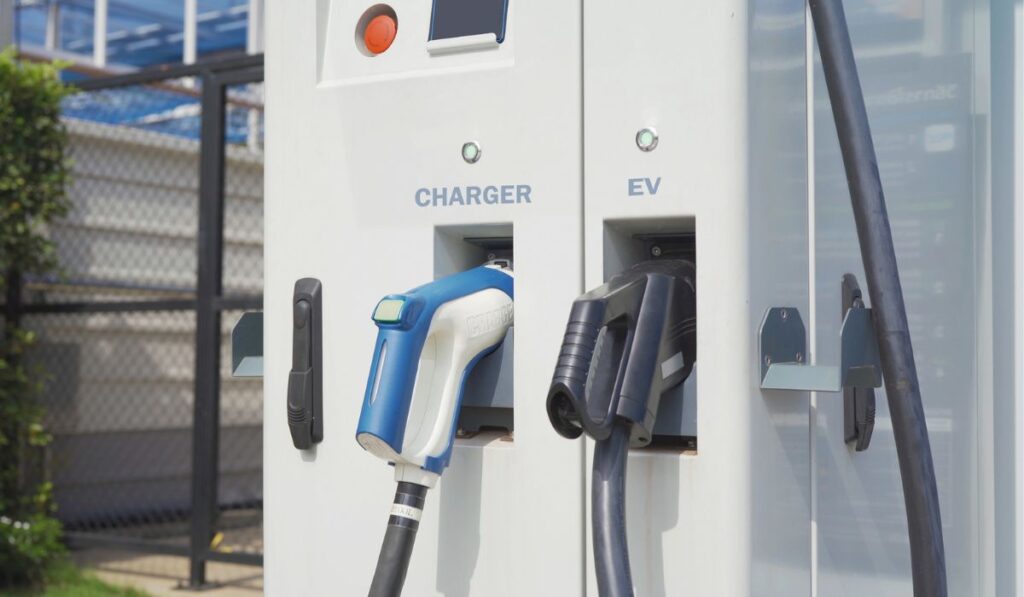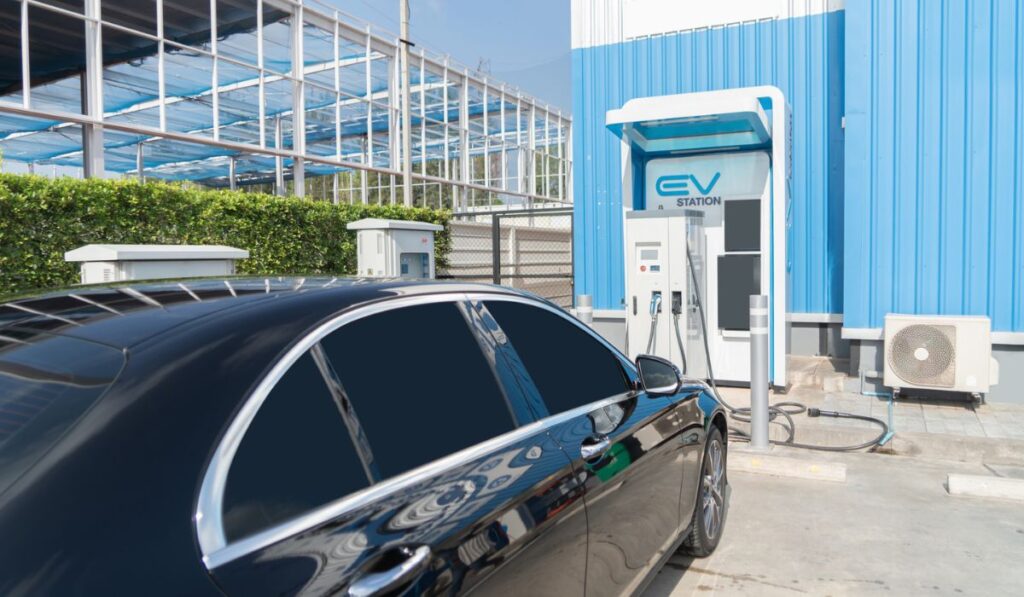More electric vehicle charging stations are popping up over the US, and electric vehicles are becoming easier to charge. However, not all charging stations are the same, and many people prefer level 2 charging stations. But what’s the difference between level 1 and 2 charging stations?
There are four levels of charging units for electric vehicles. Level 1 charges with regular socket voltage, while level 2 has a higher voltage and charges your car much faster. They also differ in terms of the effect on battery life, power, current, and connector types.
Let’s explore the different levels of charging units for electric vehicles in detail to get an idea of which suits your vehicle best.
What is the Difference Between Level 1 and Level 2 Charging Stations?

While many level 1 charging stations are cheaper for electric vehicles, most are marked as “level 2.” The main difference is that level 2 charging stations use higher voltages and will charge your car much faster.
Before looking at the differences between the two in detail, let’s first explore how these chargers work:
Level 1 Chargers
Most electric vehicles come with a level 1 charger. These are convenient as they can be used in most places and don’t cost extra. Level 1 chargers are portable units that use regular plug sockets to charge the vehicle.
Level 1 charging units use 120V, just like most daily electric appliances. Every hour you charge your vehicle on this unit, it will cover an average distance of 4 miles. It usually takes around 25 to 30 hours. To fully charge your car with this charger.
Level 1 chargers require an electric current of below 20 Amps. They deliver between 1.3 to 2.4 kW of power to your vehicle. Higher electric power translates into a longer distance covered for every hour of charging.
Level 2 Charging Unit
A level 2 charging unit needs to be bought separately for most electric vehicles. These charging units aren’t movable, and you’ll need to connect them to wall-mounted charging portals.
There are public Level 2 charging stations where you can get your car charged or have one installed at your home. However, they use a voltage of 240 v and cannot be connected to any ordinary electric outlets.
These charging stations take around 10 to 12 hours to fully charge your car. Moreover, every hour you charge your vehicle on this charger, it will cover a distance of about 25 miles.
Not only are these chargers faster, but their range is also much longer than level 1 chargers. Their average electric power is between 3 to 19 kW, with most EVs in the 6 to 8 kW range. The current required for a level 2 charger is between 12 to 80 Amps depending on your vehicle’s specific battery and type.
On the downside, level 2 charges cost a lot more than level 1 ones, with a price range between $500 to $1000. Though expensive, they are a good investment in the longer run, especially if you install one at home.
Level 1 vs. Level 2 Charging
Here are the main differences between Level 1 and Level 2 chargers:
Battery Life
Level 2 chargers take less time to charge, almost half that of a level 1 charger. Moreover, you can go longer distances with level 2 chargers for the same number of hours your vehicle took to charge.
To cover 100 miles, level 2 charges need around 4.5 hours of charging, on average. In contrast, a level 1 charger takes approximately 18 hours for the same distance.
Range
Both chargers have a significant power difference, resulting in a difference in distance covered with the same charging time.
Charging your vehicle with a level 1 charger will cover an extra 0.1 miles with every minute of charging. Whereas with level 2 chargers, it can cover 0.4 miles per minute of charging. This may vary depending on the type of vehicle and how low the battery is when you plug it in.
Voltage
Level 1 chargers use a voltage of 120, whereas level 2 chargers require an electric outlet of 240 volts.
This voltage difference is vital because level 1 charges can be connected to any electric outlet at your home, but level 2 chargers require a separate electric outlet of higher voltage.
So, if you want a level 2 charger for your electric car, you’ll also have to spend money on installing an electric outlet at your home. Also, setting up a Level 2 charging station is more expensive, so charging your vehicle at these stations is more costly.
Power
Electric power is the rate at which electric energy is transferred in a circuit. Higher electric power in a connection means a higher rate of flow of electric energy and hence, faster charging.
The electric power used by a level 1 charger is 2.4 kW on average, whereas that by a level 2 charger ranges between 4 to 19 kW. Most level 2 charges use an electric power of 7 kW.
Current
Electric current is the net flow of charge in a circuit. Higher electric current means higher electricity usage. Both level 1 and level 2 charges use alternating current (AC). Level 1 charges use an electric current of 12 to 16 Amps, while level 2 chargers use a current in the range of 15 to 80 Amps.
DC chargers are much faster but are also more expensive to install.
Connector Type
There are currently three types of connectors used in electric cars, the J1772, the CHAdeMo, and the CHAdeMO 2.0. Both level 1 and level 2 charging stations require J1772.
If your vehicle isn’t compatible with this connector, you can always use an adapter to charge at these stations.
Should You Get a Level 1 Charger or a Level 2?

When choosing which one of these chargers to buy, think of the distance and frequency of your everyday travel, your budget, and the amount of time you can spare for charging.
If you travel frequently or need to go longer distances, level 2 chargers will be more convenient since they cover more distance and take less time to charge. You don’t want to run out of power in the middle of the road and don’t have the time to wait hours to recharge your car.
Since the per unit cost of electricity used by level 2 chargers is higher than level 1, and these charges will cost you a few hundred dollars extra, you might be tempted to stick to level 1 chargers.
However, while the per unit cost is higher for level 2, the time it takes to charge with them is less; hence the prices of charging do not vary greatly between the two. The initial investment of $500 to $1000 on a level 2 charger is worth it when you compare the time it spares you and the extra miles it gives you for traveling.
If money isn’t a problem, you can also try level 3 or 4 charging stations.
What is a Level 3 Charger?
Level 3 chargers, called DC Fast Chargers, use direct current to charge electric vehicles. Most standard electric equipment, including level 1 and 2 charges, use AC (alternating current). DC makes level 3 chargers much faster than level 1 and 2 chargers.
These chargers use around 500V and 250 kW of electric power, which ensures fast charging times. For example, a level 3 charging station takes less than 30 mins to charge your vehicle for at least 100 miles.
Charging stations for level 3 charging are publicly available, although not on a scale as large as level 2. In addition, having the stations installed at a private residence will cost a lot as the process includes changing the entire electricity system.
So, a public station is viable if you want to utilize fast level 3 charging.
Are There Level 4 Chargers?
Although not publicly available for most EVs, the level 4 charge, also called DC Ultra-Fast Charger, is said to be super-fast. This is because it connects directly to the power grid and uses direct current (DC).
These chargers use over a megawatt of electric power and take around 20 mins to fully charge most EVs. They require 800 to 1000 volts of current, and your vehicle can travel a distance of over 22 miles with a single minute of charging time. The connector CHAdeMO 2.0 is specifically designed for this charger.
Tesla has manufactured these super-fast chargers, but they aren’t yet being sold to individuals. And since these rare chargers will cost a fortune to be installed at your home. In the US, Level 4 chargers are available in limited public charging stations.

Paul Kale Electric, Inc.
Tuesday 19th of September 2023
Hi, will a Vevor 16A, 240V, EV charger work with a 208V circuit.